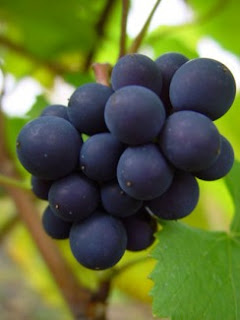 It’s often said these days that Pinot Noir is the ultimate “food wine.” Not that it goes with “everything” or is the wine that everybody loves. But it does have the highest percentage chance of matching any specific dish than any one other wine type.
It’s often said these days that Pinot Noir is the ultimate “food wine.” Not that it goes with “everything” or is the wine that everybody loves. But it does have the highest percentage chance of matching any specific dish than any one other wine type.Or does it? Well, let’s talk Pinot. Not all Pinots are alike, but generally speaking they come with a light to medium sized body, moderate and relatively soft tannin, mild but perceptive acidity, marked textural qualities (“velvet” or “silk”), and sachet-like bundles of flower, spice, berry and herb perfumes wrapped in subtle vanillin, smoky qualities of the French oak virtually always applied to the grape.
The typical Pinot Noir’s moderate tannin in particular gives it a flexibility to match both red and white meats with almost any degree of fattiness; and its mild acidity is often just crisp enough to broaden its range of white meats from pork, veal and chicken to fish and even shellfish.
Then there’s the factor of umami. Let’s not get mystical or mysterious about this taste sensation which basically occurs in foodstuffs with slightly elevated amino acids. But the fact of the matter is, although the presence of amino acids in wine is barely negligible (nonetheless there) the umami phenomenon is probably the only explanation for why naturally balanced, buoyant, soft tannin, phenol flavorful reds like Pinot Noir often make such delicious matches with the most unlikely (but umami intense) foods: like raw or seared-rare tuna in mustards and spices, oysters both raw and roasted, combinations of seafood in bourrides, cioppino and bouillabaisse, and even preparations of mussels, squid, eel and salt cod.

Enough mystique. A summary of classic food applications when matching or cooking for Pinot Noir:
- Leaner meats (veal, chicken, turkey, rabbit, any game bird, and filets of beef or pork, and a well drained duck)
- Smoked, wood roasted, braised or sausage meats (with the use of beef, lamb and pork)
- Earthy, high umami flavors (such as truffles, wild mushrooms, mustards, peppercorns, coriander, and horseradish)
- Resiny or scented green herbs (rosemary, thyme, tarragon, oregano, summer and winter savory, chervil, mints and basils)
- Aromatic sweet spices (clove, cinnamon, mace, allspice and nutmeg)
- Sweet vegetables (such as tomatoes, beets, carrots, caramelized onions and bell peppers)
- Autumnal fruits (figs, plums, blackberry, raspberry, blueberry, currants, black and dried cherries, etc.)
- Natural stocks and sauces rounded with butter or oils and Pinot Noir
- Slow cooking processes (braises, pot a feu, etc.)
- Soft, creamy cheeses, some with zest (especially herbed crèmes like Boursin, Chèvre, Brie, Camembert, Havarti and Jacks)
- Soft, rounded wine vinegars (especially balsamics and well aged rice vinegars)
When you sear scallops with powerfully aromatic truffles or truffle oil, for instance, all of the sudden it’s a dish for Pinot Noir rather than anything white. Oregonians like to serve their Pinot Noir with Northwest Native American style plank smoked salmon. In Hawai`i, it’s all about the finest tuna, albacore or hamachi in the world, in brothy, earthy ponzus.
In my world, Pinot Noir is even license to drink red wine with sweet/spicy, earth toned or mildly bitter Asian flavors such as star anise, wasabi, hoisin, Japanese radishes, seaweeds, lotus root, fennel, toasted sesame seeds, sesame oil, mizuna, chiso, shiitakes, and even mild teriyaki marinades and glazes. All of which can actually bring out the mildly sweet, zippy, toasty, earthy, and wonderfully beefy qualities of Pinot Noir, and vice-versa.
No question, the taste of Pinot Noir becomes altered in untraditional, exotic food contexts. Traditionalist aficionados of classic red Burgundy may protest, but who cares?
MATCHING FOODS WITH OREGON’S BEST PINOT NOIRS
One of the places in the world where tradition repeatedly meets innovation -- insofar as winemaking as well as food and wine matching -- is in Oregon. In early 1999 I put together an interesting multi-chef/winemaker dinner in Honolulu, matching the Pinot Noirs of eight Oregon winemakers with eight Hawaiian regional chefs with eight distinctive styles; some 300 Pinot lovers in attendance. Events like this are often the most inspiring not so much because all the matches work to perfection (which they don’t), but because they’re bound to bring out many new and novel approaches to the grape, and lots of great ideas.
The wines, their winemakers, the chefs and their food matches:
 Lynn Penner-Ash’s 1996 Rex Hill Maresch Vineyard Pinot Noir – This firm, snappy, yet fluid, sensuously textured red with fragrances of autumn spice and smoky leaves acted as an example of just how easily Pinot fits with seafood – soft and fleshy pan seared scallops – even when served with a slightly acidic Asian green papaya salad, prepared by Philippe Padovani. Traditional thinking says that vinegary ingredients flatten out mildly tannic reds. But in this case, a sweet/spicy fruit balance in the dish seemed to underscore the bright, lively aspects of the Rex Hill.
Lynn Penner-Ash’s 1996 Rex Hill Maresch Vineyard Pinot Noir – This firm, snappy, yet fluid, sensuously textured red with fragrances of autumn spice and smoky leaves acted as an example of just how easily Pinot fits with seafood – soft and fleshy pan seared scallops – even when served with a slightly acidic Asian green papaya salad, prepared by Philippe Padovani. Traditional thinking says that vinegary ingredients flatten out mildly tannic reds. But in this case, a sweet/spicy fruit balance in the dish seemed to underscore the bright, lively aspects of the Rex Hill.On another occasion that year, we enjoyed this same Pinot Noir with wasabi cured, pan crisped salmon, finished with sea vegetable mignonnettes touched with rayu (chili oil); and the match worked like a charm. It’s amazing how many food barriers a more subdued, finely textured, yet multi-spiced Pinot Noir really can cross.
Harry Peterson Nedry’s 1996 Chehalem Ridgecrest Vineyard Pinot Noir – While slightly beefier and more aggressively oaked than the Rex Hill, the Chehalem style is also finely poised with both dense and soft qualities on the palate; all of which was ideally matched with a very novel dish by Alan Wong – smoky, meaty tuna served on bitter edged Big Island grown greens (balancing out the wine’s tannins) and a pan crisped lumpia (Filipino style dumpling) filled with, of all things, warm Cambazola cheese. Needless to say, the warm and earthy cheese made a remarkable bridge, only increasing the round, smoky qualities of the wine.
We’ve also tried this wine with roasted quail stuffed with star anise scented Chinese black rice – food components that enrich the Chehalem’s aggressively smoky style, while making an exotic match.
Laurent Montalieu’s 1996 WillaKenzie Pierre Leon Pinot Noir – It’s rare to find a red wine – such as this super smooth, yet tightly balanced, vanilla bean and peppermint spiced Pinot – that is actually overwhelmed by a fish dish, but that’s just what Russell Siu’s three peppercorn crusted salmon (further revved up by a sauce infused with red wine and veal juices) did.
While imperfect, this was at least a match illustrating the delicacy of Oregon grown Pinot Noir, and the veracity of placing “white wine” foods (i.e. fish) in classic red wine contexts to make it work; as in another occasion when we enjoyed WillaKenzie’s Pinot Noir with wood grilled mackerel, of all things, pulled together with a Pinot infusion and shiitake mushroomed sticky rice.
David Adelsheim’s 1996 Adelsheim Elizabeth Vineyard Pinot Noir – In the nineties, Adelsheim’s Pinots often come with a gamey, almost leathery edge (i.e. flourishes of brettynomyces), while finishing soft, and seductively sweet with wild berryish fruit on the palate; and quite fortuitously, Eberhard Kintscher’s crab and Portobello mushroom “sandwich,” laced with a pungent truffle vinaigrette, served to keenly match and balance out the wine’s distinctly earthy qualities. Definitely a case of dish improving the wine!
Dick Erath’s 1996 Erath Vineyards Vintage Select Pinot Noir – In this case, -- a soft, lovely style of Oregon Pinot showing the full spectrum of black, red and blue berry qualities so common to the region – the wine was slightly overpowered by Amy Ferguson-Ota’s intense, lush, succulent “Peking duck rillette.” If anything, a more strongly tannic Pinot Noir, or even Syrah, would have pushed the match closer to the fat part of the bat.
Mark Vlossak’s 1996 St. Innocent Seven Springs Pinot Noir – This would qualify as a more voluminous style of Oregon Pinot, firmed up by muscular tannin and generous, aromatic qualities of blueberry, pepper spice, and even suggestions of earthy soy; proving to be a terrific match with Jean-Marie Josselin’s French and backyard Hawaiian inspired veal cheeks served in a Pinot Noir sage reduction over a root vegetable puree. Not as complex a dish as it sounds, but rather something earthy and elemental, which are perfect Pinot qualities.
 Ken Wright’s 1997 Ken Wright Cellars Guadalupe Vineyard Pinot Noir – Wright’s fame is based on his unerring ability to coax out the purest possible soft, tender, fresh berry flavor in Oregon grown Pinot Noir, and this bottling was textbook. In this course, George Mavrothalassitis’ licorice smoked squab with sesame oil and gingery accents seemed to intensify both the meaty and hidden Asian spice elements in the wine – an unexpected, and blessedly rare, occurrence of wine and dish bringing out the best in each other.
Ken Wright’s 1997 Ken Wright Cellars Guadalupe Vineyard Pinot Noir – Wright’s fame is based on his unerring ability to coax out the purest possible soft, tender, fresh berry flavor in Oregon grown Pinot Noir, and this bottling was textbook. In this course, George Mavrothalassitis’ licorice smoked squab with sesame oil and gingery accents seemed to intensify both the meaty and hidden Asian spice elements in the wine – an unexpected, and blessedly rare, occurrence of wine and dish bringing out the best in each other.But the pure, penetrating quality of Ken Wright Pinots also make them versatile; as we’ve discovered in other dinners, serving it with lighter variations of truffled poke (Hawaiian style raw fish chopped with sweet onions, soy and sesame oil) made with tuna or hamachi (yellowtail fish).
Mike Etzel’s 1996 Beaux Frères Pinot Noir – While certainly not “big” by, say, California Cabernet standards, this is a dense, concentrated, full throttled style of Pinot, brimming with luscious, almost sweet, smoky, spicy, beef brothy fruit, almost primordial in its forcefulness; and for this, Roy’s Gordon Hopkins shrewdly fashioned a tenderloin of pork stuffed with spicy wild boar, porcini and chanterelles, underlain by a velvety natural sauce. Anything but the Beaux Frères would have been blasted off the table; but as it turned out, the viscous, sweet and earth toned quality of the dish simply merged with the roaring fruit and smoke-of-oak of the wine.
Beaux Frères no longer makes this kind of Pinot; but when they did, they were some of the few that I would readily choose over standard issue Cabernet Sauvignon for dishes such as slow cooked, umami intensified beef (like Yankee pot roast with juniper berries), braised lamb shanks, and stewed venison: all examples of complex, caramelized meats better served by concentrated reds dominated by sweet, fragrant spices rather than brutally hard, drying tannin.









Comments
Post a Comment